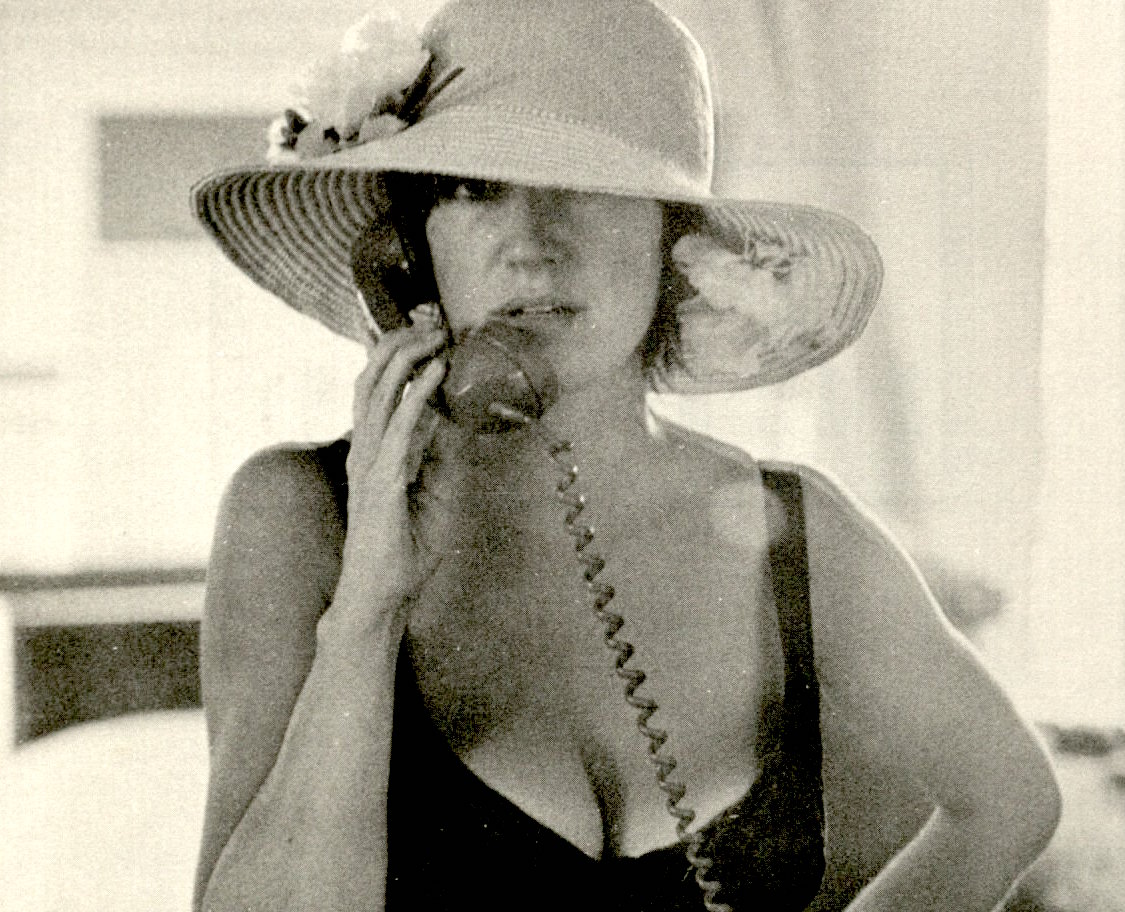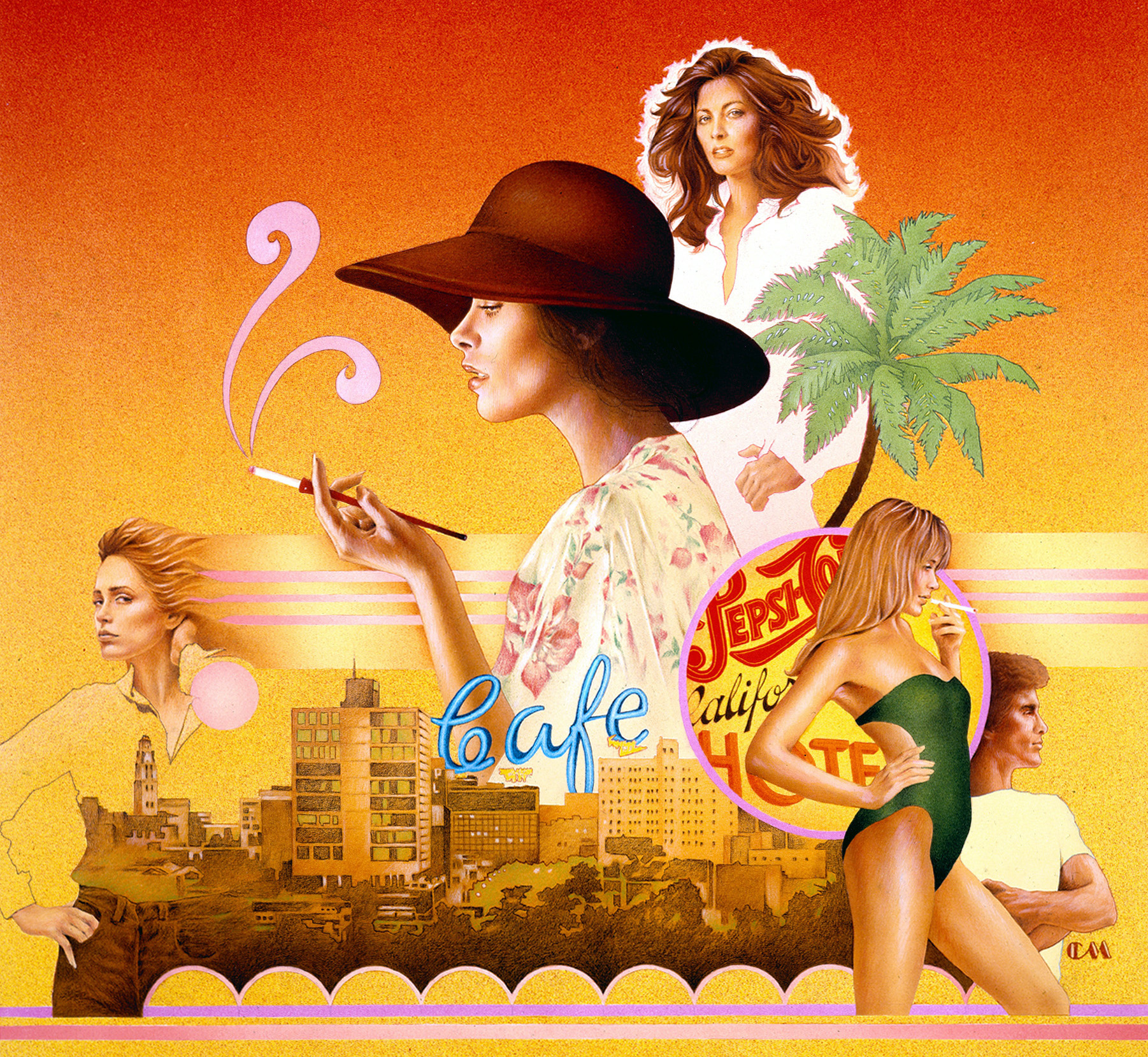Slow Days, Fast Company
Eve Babitz’s singular take on Los Angeles.
By Stephanie LaCava
Years ago, a friend gave me a first edition of Eve Babitz’s second book, Slow Days, Fast Company (1974), which had slipped out of print. Tucked inside was a promotional photo of the author on thick, glossy Kodak paper; the back cover, featuring the same image, explained that Babitz had begun to write in 1972 after a stint designing album covers for Atlantic Records. It neglected to mention that she’d had romances with the portrait’s photographer, Paul Ruscha, and his brother, the artist Ed Ruscha—a kind of discretion she’s not often afforded.
Most discussions of Babitz’s writing are preceded by a list of her paramours or a seemingly obligatory nod to the iconic 1963 photograph in which Babitz, nude, plays chess with Marcel Duchamp. I wouldn’t care so much about Babitz having dated Jim Morrison—one of her admitted “tar babies”—or having posed with Duchamp, except that her love life plays nicely into her game on the page: one of sharp, funny, memoiristic essays set in the late sixties and seventies Los Angeles scene. Babitz claims she started these studies at age fourteen. I believe her. She’s been working since she was a teenager, closely observing the people around her—few of whom, presumably, suspected that such a pretty party girl could be so gimlet-eyed.
“I looked like Brigitte Bardot and I was Stravinsky’s goddaughter,” Babitz writes of herself in Eve’s Hollywood, her first book, reissued this fall. She’s hyperaware of her beauty and her pedigree, and they prove to be useful assets. (She also tells us that it was Stravinsky who gave her scotch when she was thirteen and slid rose petals in her top on her sixteenth birthday.) Growing up, Babitz lived in the back of her parent’s house in a tiny bungalow on Bronson Avenue. Her father was a Baroque musicologist with a Fulbright and Ford grant, and friends like Stravinsky, Arnold Schoenberg, and Thomas Mann. Her artist mother, Ed Ruscha told me, was “a real sweet beautiful woman from a little town in Texas.” Babitz seemed to have inherited the best qualities from both.
The episodes in Eve’s Hollywood are sometimes only a few paragraphs long, with titles like “Daughters of the Wasteland,” “Ingenues, Thunderbird Girls and the Neighborhood Belle: a Confusing Tragedy,” and “And West (né Weinstein) Is East Too.” Throughout, Babitz is bitingly self-aware, the perfect faux naïf. In Slow Days, the follow-up to Hollywood, she responds to the new varieties of attention her writing got her:
I wasn’t as used to the new dumb questions, so when men I had once thought of as wise daddies now asked me “How do you write?” I did not try and spill red wine in their suede pants, I would just smile and say, “On a typewriter in the mornings when there’s nothing else to do.”
Babitz addresses the Los Angeles lifestyle outside in, as if looking on from a distance, though she’s never left home. This is her milieu by birth and adoption; she coopts its breeziness. In Hollywood, in a chapter called “The Sheik,” Babitz writes about “the Jim Morrison phrase which occurs to me whenever I think about some foolhardy, glamorous, and fatal adventure, he was ‘trapped in a prison of his own devise.’ ” She goes on cheekily, “Hollywood herself was always trapped in a prison of her own devise, but don’t think about that (because if you do you’ll start wondering what devises are, anyway, if not prisons, and if you’re going to have to be trapped in one, it might as well be a Hollywood devise).” No writer has a keener eye for the ways in which Hollywood is ensnared in its own myth making.
Throughout Babitz’s stories, there’s an awareness of the dichotomy between the often vapid realities of Los Angeles and the ideals of an authentic Bohemia; she wonders, too, about the divide between the life of an “adventuress” artist and a reliable, settled wife. In Slow Days’s “Sirocco,” she remembers driving with her mother to a wedding—she’d been engaged, at various times, to both the groom and the best man. “I’d broken off with both of those guys because I was impatient with ordinary sunsets,” she writes. “I was sure that somewhere a grandiose carnival was going on in the sky and I was missing it.”
Likewise, in “The Garden of Allah,” she writes about everyone’s girl crush, Mary, “a laughing blond, beautiful dilettante who always said the right things.” Mary gives in and marries a man who doesn’t approve of her Los Angeles friends. “But it wasn’t just the money. I knew it couldn’t be just the money. It was that she was afraid of getting old without living out a girlhood fantasy of one day marrying and having children and a house and a business-husband.” The cumulative effect of withering pronouncements like these, scattered throughout both collections, leaves an impression on the reader. It’s as if Babitz is preserving her ability to unsettle by couching it in levity.
In the beginning of Slow Days, Babitz writes, “Perhaps if the details are all put together, a certain pulse and sense of place will emerge, and the integrity of empty space with occasional figures in the landscape can be understood at leisure and in full, no matter how fast the company.” Its version of abstraction reminded me of another writer enjoying a renaissance this year: Clarice Lispector. Her fiction covers similar terrain, and there’s a strange, undeniable sisterhood in the way she displaces the reader with her language, using phrasing that is deliberately—misleadingly—lightweight. Both Babitz and Lispector play with the expectations surrounding their beauty; and both suffered severe burns later in life, damaging the good looks they were known for. Their superficial assets superseded their work, which would have been laughable were they not aware. Lispector had her own style of challenging this notion. Babitz’s was often in saying exactly what she saw—maybe embellishing it just a little. Her interest in appearances, and regard for her own, isn’t so simple.
Like Lispector and Ruscha, Babitz is obsessed with the void between language and meaning. She writes in the opening note of Eve’s Hollywood, “I am really an artist, not a writer. So, I like the way Arabic numbers look un-written out on a page.” This early disclaimer should have been accompanied by another announcing Eve’s admitted inability to spell (“It’s strange to hear my friends’ astonishment the first time they receive a letter from me and find the word sacrileges—but how is it spelled?” she later writes.) A few pages in to the dedication there’s a telling error: “And to Marcel Duchamps who beat me at his own game.” Babitz knows she owes much of her notoriety to Duchamp, but she can’t be bothered to spell his name correctly—and neither, I guess, could the copy editor.
Ruscha, himself kind of a faux naïf, seems captivated by Babitz’s ease, her unaffected self. “She was really intelligent and up-to-date, into out-of-the-way things, unpopular things, avant-garde,” he told me. “Our little Kiki de Montparnasse pulled it off.”
Stephanie LaCava is a writer in New York. Her work has appeared in Interview, The Los Angeles Review of Books, and other print and online publications, including Vogue and Tin House.




No comments:
Post a Comment